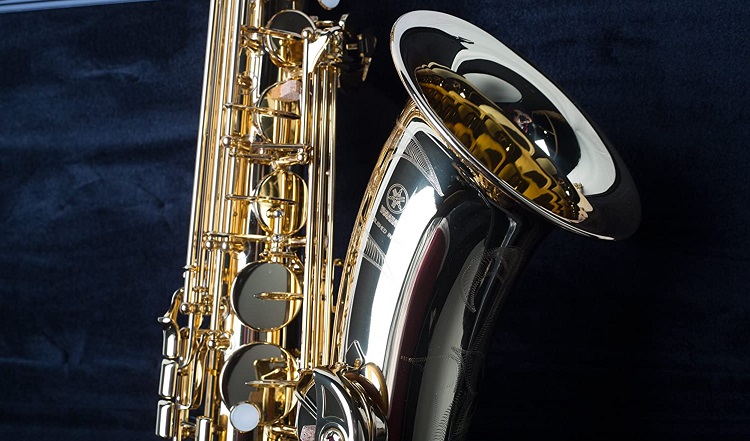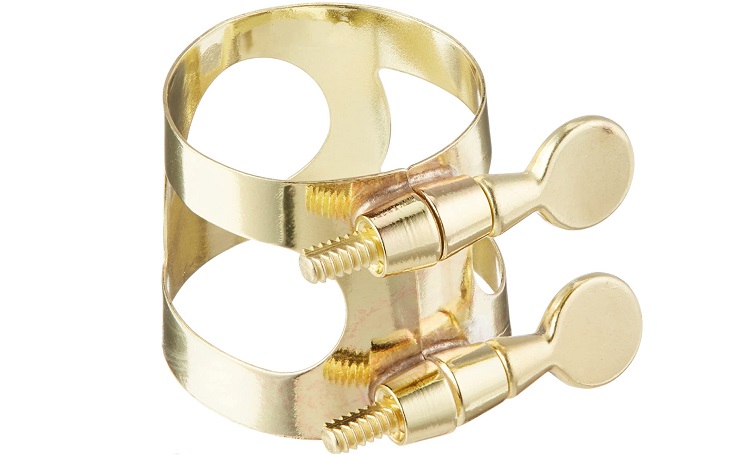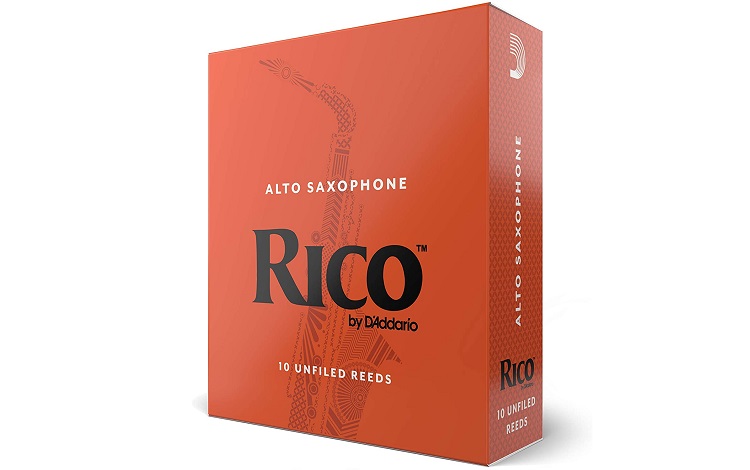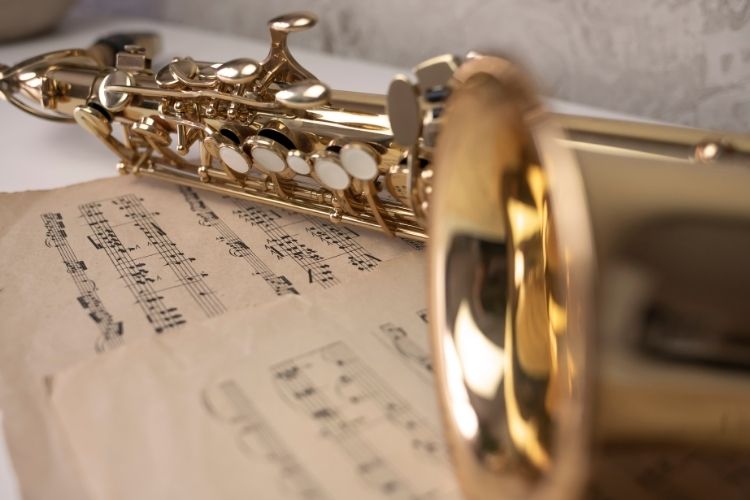- Top Trumpet Embouchure Techniques: Options for Beginners Through Professionals - October 12, 2022
- Is the Trumpet Hard to Learn? - September 30, 2022
- Best Leblanc Clarinet Models Guide: From Soprano to Contrabass - September 5, 2022
Did you know that the saxophone is less than 200 years old? Compared to other instruments, it’s like a baby. But that shouldn’t keep you from learning how to play saxophone.
If you want to blend the sound of a brass instrument with the design of a woodwind, the saxophone is perfect for you. Anyone can learn to play the instrument, and the design makes it easy for beginners. Are you ready to learn the saxophone? Consider what you should do now and once you get your first instrument.
What Is The Saxophone?
The saxophone is a family of single-reed woodwind instruments. Adolphe Sax invented the instrument in 1846, and it features a metal tube with keys that open and close the different tone holes. Most saxophones have a J-like curve because of the length of the tube. However, smaller saxophones, like the soprano, can have a straight tube.
Other popular types of saxophones include the alto, tenor, and baritone. Alto and tenor are the most common saxophones for beginners, and you can move to other sizes after a while. All saxophones are transposing instruments, which means the note you see on the page isn’t what you hear when you play. Each saxophone is in either E flat or B flat.
The alto saxophone in E flat, so it reads a major sixth higher than it sounds. Meanwhile, the tenor saxophone is in B flat, and it reads an octave and a major second above how it sounds.
Best Saxophones For Beginners
If you want to learn how to play saxophone, you need a good quality instrument. You can find tons of instruments online, and some can be very cheap.
However, the cheapest saxophones usually come with a lot of problems. Fortunately, reputable brands are available, and they aren’t too expensive.
Consider some of the best saxophones for beginners.
Yamaha YAS-280

The Yamaha YAS-280 alto saxophone is an excellent first model as you start learning. I’ve played another Yamaha saxophone, and this is the newest version of the student model from Yamaha. It comes with all of the keys you need to play saxophone and learn quite a bit of music. While the highest note a saxophone usually plays is an F, this model has a special key that allows you to play the F# just above that.
This model comes in a nice case you can use to store and transport the instrument. And it includes essential accessories, such as a mouthpiece, ligature, and neckstrap.
Pros
- Great specs for a beginner
- Fantastic quality
- Comes with what you need
Cons
- A little expensive
Jupiter JAS710

Another fantastic saxophone for beginners is the Jupiter JAS710 alto saxophone. It features the standard keys and specs that any beginner saxophone should have, such as rollers to help move between pinky keys. The body is lacquered brass, and the keys are nickel-plated brass. This saxophone is durable and can handle a lot from a beginner saxophone player.
Jupiter also uses a contoured design to make the left hand more comfortable. If you want to use the same instrument for a long time, this has what you need.
Pros
- Excellent specs
- Ergonomic design
- Quality materials
Cons
- No neckstrap
Jean Paul USA AS-400

The next beginner saxophone to look at is the AS-4oo from Jean Paul USA. It has a similar design to other beginner saxophones, including ergonomic keys, and the materials are durable. There’s a high F# key, so you don’t have to worry about upgrading for one note. The brass body has a lacquer finish, so the instrument looks and sounds good.
Unlike other saxophones, this one comes with plenty of accessories, including a swab, cleaning cloth, and reed. That way, you can start playing as soon as you get the instrument.
Pros
- Comes with everything you need
- Affordable
- Good design
Cons
- Quality control issues
Yamaha YTS-480

If you’d prefer to learn on a tenor saxophone, consider the Yamaha YTS-480. It offers an excellent response and a nice, warm tone to help you get a good sound. There are also new keyguards to help protect some of the keys on the curve of the instrument. And as you advance and want to experiment with different saxophone parts, you can keep the same body.
While it’s not a beginner model specifically, it can be a great first tenor saxophone. You can play it as you learn, and you can keep up with it over the years.
Pros
- Great design
- Warm tone
- Flexible for different players
Cons
- Expensive for a first-time player
Saxophone Accessories You Need
While having a good quality saxophone is important, you also need some accessories. Unfortunately, you can’t just pick up a saxophone and play it without some additions. However, you don’t have to search everywhere to find good saxophone accessories. As long as you know what you need, you can buy the accessories and use them for a while.
Here are a few things you’ll need to learn how to play saxophone.
Mouthpiece

Most beginner saxophones will come with a good mouthpiece so that you can make a sound. You’ll combine the mouthpiece with a reed (more on that later), to produce a sound on the saxophone. As you start to progress, you may want to upgrade to a mouthpiece like the Yamaha 4C. You can buy different mouthpieces to use in different genres, such as classical and jazz music.
If you happen to buy a used beginner saxophone, you may also need to buy a separate mouthpiece. When buying used, be sure to ask if the seller will include a mouthpiece or not.
Ligature

The ligature is what connects the reed to the mouthpiece, and it’s another crucial saxophone accessory. Again, most beginner saxophones will include a ligature, so you don’t need to worry about that yet. However, you can upgrade to a ligature with a different design or material. As you blow into the mouthpiece, the sound can vibrate, and the ligature can affect the sound you get.
In most cases, you can learn on the ligature that comes with your first saxophone. But there may come a time when you want to experiment with your sound, and switching ligatures is an affordable, temporary way to do that.
Reeds

Reeds can be the bane of every saxophone player’s existence, but you can’t make a sound without one. A reed is what causes your air to vibrate and create a sound on the saxophone. You can find reeds from different companies, and reeds come in different strengths. Strengths range from 1.5 to 5, including 0.5 increments.
Thinner reeds with a strength of 2 or 2.5 are perfect for beginners. They’re more forgiving than stronger reeds, so you can get a sound more easily. But thicker reeds can give you more control over your sound. You’ll need to buy a few reeds so that you always have a good one available. While you don’t need to make the reeds yourself, some of them won’t play as well.
When buying reeds, make sure to get the correct size as well. What works with an alto sax mouthpiece won’t fit on a tenor and vice versa. The same applies to saxophone mouthpieces and ligatures.
Neckstrap

Another important accessory that will support you as you play the saxophone is a neckstrap. Saxophones can be heavy and awkward to hold, and a neckstrap helps distribute that weight. You should look for a comfortable neckstrap that will take the pressure off of your hands. That way, you can move your fingers more freely as you learn to play more notes.
I, personally, prefer using a thinner neckstrap so that my neck still has flexibility. However, other players like thicker straps, like the Neotech neckstrap. Many beginner saxophones come with a neckstrap. But buying one separately can still be a good idea so that you can feel comfortable as you learn the sax.
Starting On Alto Vs. Tenor Saxophone

Another important thing to think about when learning how to play saxophone is which type of saxophone you should get. Alto and tenor saxophone are the two most common types, and both are suitable for beginners.
However, there are some differences worth considering. In most cases, the alto saxophone is a better option, but some players may want to jump straight into playing tenor sax. Consider the following factors to help make your decision on which saxophone to play first.
Access
First, you have to get your hands on your saxophone of choice. Whether you decide to buy a saxophone or rent one from a music store, you will usually have more options for alto saxophones. The alto saxophone is slightly more common than the tenor, and it’s great for players of all ages. You can find more beginner alto sax models in a music store or online.
If you decide to buy a used saxophone, you may also be able to find an alto sooner. That way, you don’t have to wait as long before you can start learning to play.
Size
Some saxophones can be big while others are small. Luckily, the alto and tenor saxophones are far from both extremes. But the alto saxophone is smaller than the tenor, so it’s a better option for younger players and people with shorter arms.
The keys are closer together on alto sax, making it easier to play for people who have smaller hands. Tenor saxophone also requires a slightly longer reach with your right arm because of the longer body. Also, the alto saxophone isn’t quite as heavy as the tenor. If weight is a huge concern, you may want to go for the smaller instrument until you get the hang of it.
As an adult, you can learn whichever saxophone you prefer so that you can maintain the motivation to practice. But kids should learn the alto first until they’re big enough to comfortably play the tenor.
Tone

A more subjective factor to consider is the tone of the instrument. Alto saxophones are in the middle of the range, so they aren’t too high or low. While tenors are a bit low, they aren’t as low as other saxophones. Still, the extra size gives tenor saxes a warmer sound. If you like to listen to or play lower parts, then tenor may be a better fit for you.
However, other factors, like the mouthpiece, ligature, and reed can also affect the sound. You may be able to get a richer tone on an alto with the right combination of accessories. Overall, the tone is personal, so consider what you like about the saxophone. If you want to play the melody in a jazz band, alto may be a better fit, while the tenor offers a lower sound.
Tuning
Another thing to think about is how to tune the instrument. Both alto and tenor sax share the same written range of notes, so once you learn one, you can switch to the other.

However, the tenor sax is in B flat, while the alto is in E flat. That means when a tenor sax plays the note C, it will sound the same as a B flat on the piano. When the alto sax plays C, it will sound like an E flat on a piano. While this isn’t a huge deal when you play alone, it’s important to consider when you join a music group. You’ll need to know what notes to play so that you can tune your saxophone with others.
And you should know the transposition when looking for music. Of course, you can play saxophone music. But you can easily transfer clarinet music to tenor sax since they have the same transposition, but the sax will sound an octave lower.
Price
Like it or not, you should consider how much it will cost you to play the saxophone. An alto saxophone will almost always be cheaper than a tenor sax of the same quality. But you should also think about the cost of accessories. You may need to buy hundreds of reeds over the course of learning the saxophone.
Because they’re bigger, you may find that a tenor sax reed costs more than one for alto. Think about how much you’re willing to spend on the saxophone. If you’re on a smaller budget, you may want to start with the alto sax.
How To Play Saxophone

Now that you have a good quality saxophone and all of your essential accessories, you can take it out and start to play. But you need to know how to play saxophone so that you can make a good sound. While the saxophone is great for beginners, it does take some work. Follow a few steps as you start to learn how to play the saxophone, whether you learn on alto or tenor.
Assemble The Saxophone
First, you’ll need to open your saxophone case, where you’ll find the instrument and accessories. Now, you can assemble everything.
- Grab the mouthpiece, ligature, and reed.
- Remove the ligature from the mouthpiece and line up the reed on the flat edge.
- Hold the reed in place and put the ligature over it, then tighten the ligature.
- Take the neck (the curvy part) from the case and place the mouthpiece over the cork. If the cork is dry, you can use cork grease to make assembly easier.
- Carefully remove the body from the case and connect it to the neck. Make sure the mechanism on the body and neck line up.
- Place your neckstrap over your head and on your neck with the hook hanging in front.
- Put the hook on the neckstrap in the ring on the back of the saxophone.
Once you put the saxophone together, you’ll be able to play it. When you’re done practicing for the day, you can follow the steps in reverse to take everything apart. Make sure you place each part of the instrument into the case carefully.
Forming An Embouchure
Now that you’re ready to start playing the saxophone, you need to form an embouchure. The embouchure is the shape your lips make to help you produce a sound on the saxophone. Bring your lower lip back and over your teeth. The reed will go on the bottom, and your lip is what protects the reed from your teeth so that the reed can vibrate.
Next, place the mouthpiece on your bottom lip and bring the top lip and top teeth down to it. The saxophone mouthpiece should enter your mouth at a 90-degree angle. You’ll also need to bring the corners of your mouth in so that they form a seal on the mouthpiece. Now, you can take a breath and blow into the saxophone.
Your First Notes

The next step in how to play saxophone is to produce different notes. Here’s where to place the fingers on your left hand.
- Find the finger buttons (white or cream-colored) and place your ring finger on the bottom one.
- Let your pinky float over the set of four keys next to your ring finger.
- Place your middle finger on the button just above where your ring finger is.
- Skip the small button and place your index finger on the next finger button.
- Rest your thumb on the thumb rest on the back of the instrument *usually a black spot).
Now, you can place the right hand on the three finger buttons on the bottom part of the saxophone. Your pinky can rest over the keys just below that. Typically, the first note you’ll learn on any saxophone is B, and the fingerings are the same for alto and tenor. You only need to close the key with the first finger on your left hand.
Add your second finger to get the note A, and you can add the third finger to get the note G. Then, you can keep adding more fingers (except the left-hand pinky) to get lower notes.
Your First Song
Once you get the hang of producing a few notes on the saxophone, you can play a couple of songs. Hot Cross Buns is one of the best first songs to play because you only need three notes.
B A G
B A G
G G G G
A A A A
B A G
Another song that only uses three notes in Mary Had a Lamb. You can play through both songs, and you can keep learning new notes to play even more music.
Get A Good Book
A good saxophone book can be an essential tool as you learn how to play. Whether you decide to take lessons or not, a book can show you how to play more notes and songs. The Rubank Elementary Method is an excellent, affordable option. Once you finish that book, you can move to the Intermediate Method to learn even more.
There are also beginner books for specific types of saxophones, like alto and tenor. Those can be good books if you’ll be learning in a group setting with people who play other instruments because they write the music to fit with a group.
Consider Taking Lessons
Taking private saxophone lessons isn’t necessary to learn, but it can be useful. Working with a private teacher means you can receive personal feedback and guidance. Your teacher can make sure you hold the instrument well and that you use enough air to get a sound. If you struggle with these things, it will be harder to advance.
And you won’t have to worry about developing bad habits. That way, you can learn how to play saxophone more efficiently.
FAQs
Answer: Learning to play the saxophone is as easy or as hard as you make it. Compared to other instruments, like the flute or clarinet, it’s easy to get a sound on the saxophone as a beginner.
However, you need to get a good reed to use with your saxophone. If the reed is too strong, you may not be able to get a sound out.
Answer: Yes, you can teach yourself how to play saxophone. However, you will need to be self-motivating and have the discipline to practice regularly.
You don’t need to play the saxophone every day, but you do need to be consistent so that you can learn new things. Then, you can start to play even more songs.
Answer: The alto sax is easier for smaller players, including children and shorter adults. Keys are easier to reach, and the instrument isn’t as heavy.
However, the tenor can be just as easy for adults and taller kids to learn. Consider which one interests you more because interest can be a great motivator.
Answer: In my opinion, the saxophone is easier than the clarinet. While the saxophone requires more air volume, the clarinet requires more air pressure to get a good sound.
I also had the benefit of learning the saxophone before the clarinet, so that could affect my experience. If you already play the clarinet, learning saxophone will be a breeze. And if you haven’t played the clarinet, the saxophone is still great to learn.
Answer: Jazz is probably the most common genre for saxophone, but it’s not the only type of music that you can play. Now, there aren’t as many classical pieces for saxophone as for the flute or violin, but there are some.
You can also play pop or rock music on the saxophone. One excellent sax solo to check out is in the song “Money” by Pink Floyd.
Answer: The saxophone is for anyone who wants to play it. While a lot of boys and men play it, more girls and women are learning the instrument.
All you need to learn how to play saxophone is the desire to learn. If someone tells you that you can’t play the saxophone, ignore them and find a way.
Final Note On How To Play Saxophone
Learning how to play saxophone is an excellent experience. You can learn the instrument relatively easily, and you don’t need any special experience to play.
Then, you can enjoy playing music in a variety of genres, from jazz to rock. Whether you want to play the alto or tenor saxophone, all you need is a good instrument and some determination.
